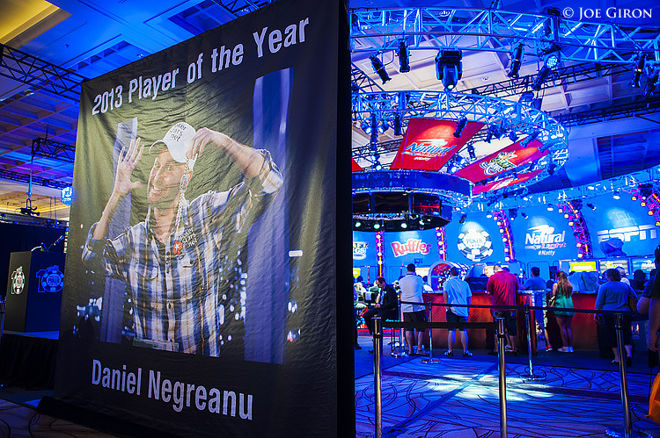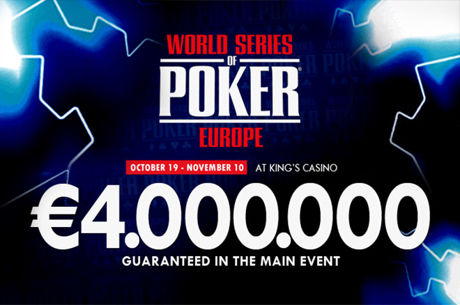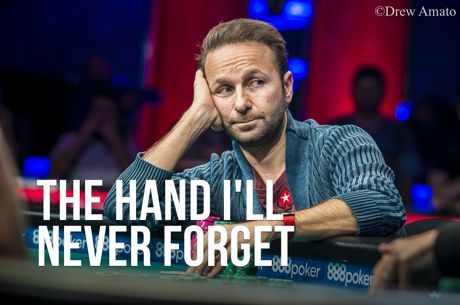Poker Leaderboards and Player of the Year: What's the Point?


Recent opinions on the WSOP 2017 Player of the Year (POY) have been wide ranging to say the least. It seems that creating a system that properly balances the skill and luck components of a poker event is not easy. Throw in the fact that you need to make the system straightforward and easy for people to understand, and it becomes a daunting task indeed.
Figuring I should get some meaningful results in a day or two fumbling around on an Excel spreadsheet, I emerged about three weeks later, thoroughly humbled, and with more questions than answers. Still, I feel it's worth presenting what I've come up with in hopes of stimulating further discussion. Maybe it will help improve not just the WSOP POY system, but leaderboards overall as well as people's understanding of why we should (or should not) have them.
Firstly, a few caveats - I am by no means an expert in statistics or Excel, but I believe what I've done is a start. Also, I won't go over all details of what I did, so as to save time and space. Rather, I'll highlight concepts and include some basic calculations for clarification where necessary. Let's move on.
Model Concept
To evaluate the performance in a series of events, we first need to work out how to measure it within a single event.
I've chosen to look at the following:
- Player's final standing in the event
- Event structure
- Number of entrants
- Buy-in
- Number of game variants
1. Player's final standing in the event: I've used a logarithmic function to give more weighting to players finishing higher up than those just making it in the money (ITM).
2. Event structure: this is probably where I think the biggest change for leaderboards should take place. I'm proposing that the more 'play' an event provides a player, the more weight or points it should contribute to the leaderboard. By 'play', I mean how long the event is expected to run for, which takes total chips in play and minutes per level into consideration.
So for example, if we take two no-limit hold'em (NLHE) tournaments that are both $1,500 buy-ins and 500 entrants with the same blind structure - but Tournament A has a starting stack of 2,000 chips and 20 minute levels, and Tournament B has a starting stack of 10,000 chips and 60 minute levels, they should be valued differently, correct? Conventional thinking (and using WSOP 2017 Event #12 - $1,500 NLHE event blind structure) would lead you to estimate that Tournament A will take around 8 hours to finish and tournament B around 30 hours. If we agree that more 'play' means more skill involved, then tournament B should have more weighting than tournament A when calculating points. (However, this would not seem to be the case with the WSOP POY 2017 - just compare Event #63 and Event #65).
WSOP POY 2017 - Event #63 & Event #65 Comparison
Buy-in: $1,000 / $1,000
Entrants: 1,750 / 1,413
Starting Chip Stack: 5,000 / 5,000
Tournament Duration: ~30 hours (level 30) / ~14.5 hours (level 29) — around a 51.7% difference
POY Points for 1st: 202.4 / 191.7 or a difference of around 5.3%
The points allocated to each tournament are quite similar for a tournament that played more than 2x the duration of the other. Using one setting on my POY calculator, the points for 1st would be 686.37 / 430.38 or a difference of around 37.3%, which would seem to be a fairer representation of the differences between the two events.
3. Number of entrants: The concept of the more opponents = more skill required is debated, only because at some point, stack sizes begin to dictate hand frequencies (as opposed to minutes / level in the earlier parts of tournaments). In isolation, it could be a linear relationship (2x the field is 2x the difficulty), but I've reduced the impact to being 1.5x the difficulty.
4. Buy-in: his is quite subjective. Using $1,000 events as the base, I've assumed a $5,000 event is 2x more difficult, a $20,000 event is 4x more difficult and a $100,000 event is 10x as difficult.
5. Number of game variants: I've made a linear assumption that for each additional game variant (regardless of type for simplicity), adds a 50% level of difficulty. For example, H.O.R.S.E would be 3x as difficult as a PLO event.
Sample Revised Top 20 WSOP 2017 POY
So with all that said, let's see what my calculator comes up with. We can play around a bit with the settings to adjust how the weightings are valued.
Here's a top 20 ranking for WSOP 2017 using settings that value on field size and event duration.
| Name (WSOP 2017 Ranking) | Sum of Total Points | Sum of Bracelets | Sum of Cashes |
|---|---|---|---|
| 1. Kenny Hallaert (10) | 4,307.25 | 0 | 9 |
| 2. Ryan Hughes (2) | 4,146.73 | 0 | 16 |
| 3. Chris Ferguson (1) | 4,047.96 | 0 | 17 |
| 4. Alex Foxen (7) | 3,892.18 | 0 | 14 |
| 5. John Racener (4) | 3,657.66 | 1 | 17 |
| 6. Dario Sammartino (9) | 3,614.90 | 0 | 8 |
| 7. Ben Yu (6) | 3,596.42 | 1 | 12 |
| 8. Barry Greenstein (13) | 3,590.94 | 0 | 13 |
| 9. Daniel Negreanu (8) | 3,457.15 | 0 | 11 |
| 10. Kevin Eyster (31) | 3,450.59 | 0 | 12 |
| 11. Mark Radoja (36) | 3,449.54 | 0 | 9 |
| 12. Boris Kolev (21) | 3,448.32 | 0 | 11 |
| 13. Ray Henson (5) | 3,317.01 | 0 | 12 |
| 14. John Monnette (3) | 3,316.80 | 1 | 14 |
| 15. Ihar Soika (55) | 3,296.95 | 0 | 4 |
| 16. Pablo Mariz (19) | 3,275.20 | 1 | 6 |
| 17. Jake Bazeley (87) | 3,273.58 | 0 | 6 |
| 18. Thomas Taylor (29) | 3,263.19 | 0 | 11 |
| 19. Ismael Bojang (50) | 3,222.80 | 0 | 8 |
| 20. Richard Tuhrim (25) | 3,203.92 | 0 | 8 |
We can see that players that performed well in multiple large field events got a big boost in POY standings. Jake Bazeley and Ihar Soika both get a big boost up the rankings due to deep runs both in the Main Event as well as the Millionaire Maker. Players that did well in the Main Event but not so much in other events didn't make the top 20 (eg. Scott Blumstein (88) moved slightly up to #84 and Daniel Ott ranked in at #61 as he had two other cashes). Kenny Hallaert just takes over top spot from Chris Ferguson despite having fewer cashes, as Kenny's cashes typically were in events with larger fields.
James Obst (11), who many would consider had a phenomenal WSOP 2017 with nine cashes and the $10,000 Razz bracelet, drops all the way down to #95 due to results being primarily in small field events. David "ODB" Baker (14), with a similar performance, drops down to #89.
Here's a top 20 ranking for WSOP 2017 using settings that value buy-in size and number of variants more, but field size less.
| Name (WSOP 2017 POY Ranking) | Sum of Total Points | Sum of Bracelets | Sum of Cashes |
|---|---|---|---|
| 1. Daniel Negreanu (8) | 4,161.01 | 0 | 11 |
| 2. Dario Sammartino (9) | 4,069.57 | 0 | 8 |
| 3. Ryan Hughes (2) | 3,897.88 | 0 | 16 |
| 4. Kenny Hallaert (10) | 3,714.84 | 0 | 9 |
| 5. Chris Ferguson (1) | 3,557.18 | 0 | 17 |
| 6. John Racener (4) | 3,555.88 | 1 | 17 |
| 7. John Monnette (3) | 3,418.25 | 1 | 14 |
| 8. Ben Yu (6) | 3,250.12 | 1 | 12 |
| 9. Ian Johns (41) | 3,140.15 | 0 | 8 |
| 10. Alex Foxen (7) | 3,065.44 | 0 | 14 |
| 11. Barry Greenstein (13) | 3,012.82 | 0 | 13 |
| 12. Connor Drinan (60) | 2,997.58 | 0 | 7 |
| 13. Mark Radoja (36) | 2,978.08 | 0 | 9 |
| 14. Andrew Kelsall (20) | 2,902.11 | 0 | 10 |
| 15. Esther Taylor-Brady (23) | 2,894.09 | 0 | 8 |
| 16. Raymond Henson (5) | 2,878.55 | 0 | 12 |
| 17. Ankush Mandavia (84) | 2,848.69 | 0 | 8 |
| 18. Jake Bazeley (87) | 2,823.08 | 0 | 6 |
| 19. Shaun Deeb (22) | 2,790.25 | 0 | 10 |
| 20. Bernardo Da Silveira Dias (16) | 2,772.08 | 0 | 10 |
With this top 20, I placed higher value on variants and buy-ins which resulted in Daniel Negreanu taking over top spot, just ahead of Dario Sammartino, both players that performed well in higher buy-in and mixed game events. Interestingly, Daniel didn't really have a deep run in a large field event, yet seemingly due to the quality of his cashes, he was still able to take over top stop under these settings, which showcases the emphasis placed on game variants and buy-ins over field size. Connor Drinan (60) also got a big boost moving up to #12 and Bazeley (87) still manages to move up to #18.
Chris Moorman (18), despite winning the $3,000 NLHE 6-Max event and having nine cashes, drops to #79 due to all of his results being in lower buy-in events. Obst (11) now just misses the top 20 coming in at #22 and David "ODB" Baker (14) winds up at #37.
In Summary
My main takeaway I've learned in going through this exercise is that creating an effective leaderboard calculation is a balance between accuracy and simplicity. Generally, the more 'accurate' the calculation is, the more inputs it tends to involve, making it more complicated. I believe a good system should be willing to forego some accuracy in exchange for ease of application.
The WSOP POY 2017 calculation (and other leaderboards globally as well) are still are a work in progress. I believe that taking into account the 'play' and duration of an event should be the first consideration in any leaderboard gives more value to events that allow more for hands to be played (smoothing out the variance towards expected values and reducing the need to 'gamble' with short stacks). Giving similar POY points for Events #63 and #65 highlights the fact the WSOP 2017 POY calculation doesn't correctly represent the difference in value between these events.
What systems have other people come up with, and what feedback can I use to improve what I've discussed so far? Let me know what you think, and hopefully I've helped shed some light on this topic.
Other random thoughts:
ITM Penalty
Another adjustment to consider applying is an expected ITM penalty. If we assume that of 74 events, scheduling and rest only allows people to play an estimated maximum of 80% of these events, and using a 10% ITM rate, we would expect player to cash roughly and average of 6 events. For people that cash less than 6 times, a progressive 'correction' would be applied to adjust for players who only cash once and win a heavily weighted event (eg. winning the Main Event).
Winning Bonus
Interestingly both the current WSOP 2017 POY and my calculator don't have a bracelet winning as the leader. It could be argued that winning a tournament is the whole point and should be given a bonus. I've taken the line that the logarithmic calculation already gives a slight bonus to higher finishes, and a bonus for winning shouldn't be applied.
Purpose of a POY
I believe a POY leaderboard can add value to some participants by offering a supplementary goal or challenge for them. It can help create more awareness about the event itself as well. So long as the organizer and/or sponsors are supporting it, I believe it's a benefit. If there's not enough diversity of interest in the POY, why not just create a main POY as well as a 'minor leaderboard' based on lower buy-ins for casual players? Different leaderboards would seem to target different audiences anyways (which would seem to be a relevant marketing strategy if POYs are indeed a marketing tool), so this would be a simple solution.
Data Source
I took the data from WSOP.com results and used what was given. I also cut down the data from 10,800+ players to about the top 1,000 which just made managing the spreadsheet significantly easier.
This article was written by one of our community members as part of the PN Blog. The thoughts, opinions, and strategy are those of the user only and do not necessarily reflect the positions of PokerNews. We appreciate your feedback, but ask that you be respectful of our PN Blog users who have generously donated their time. You can learn more about the PN Blog here.








